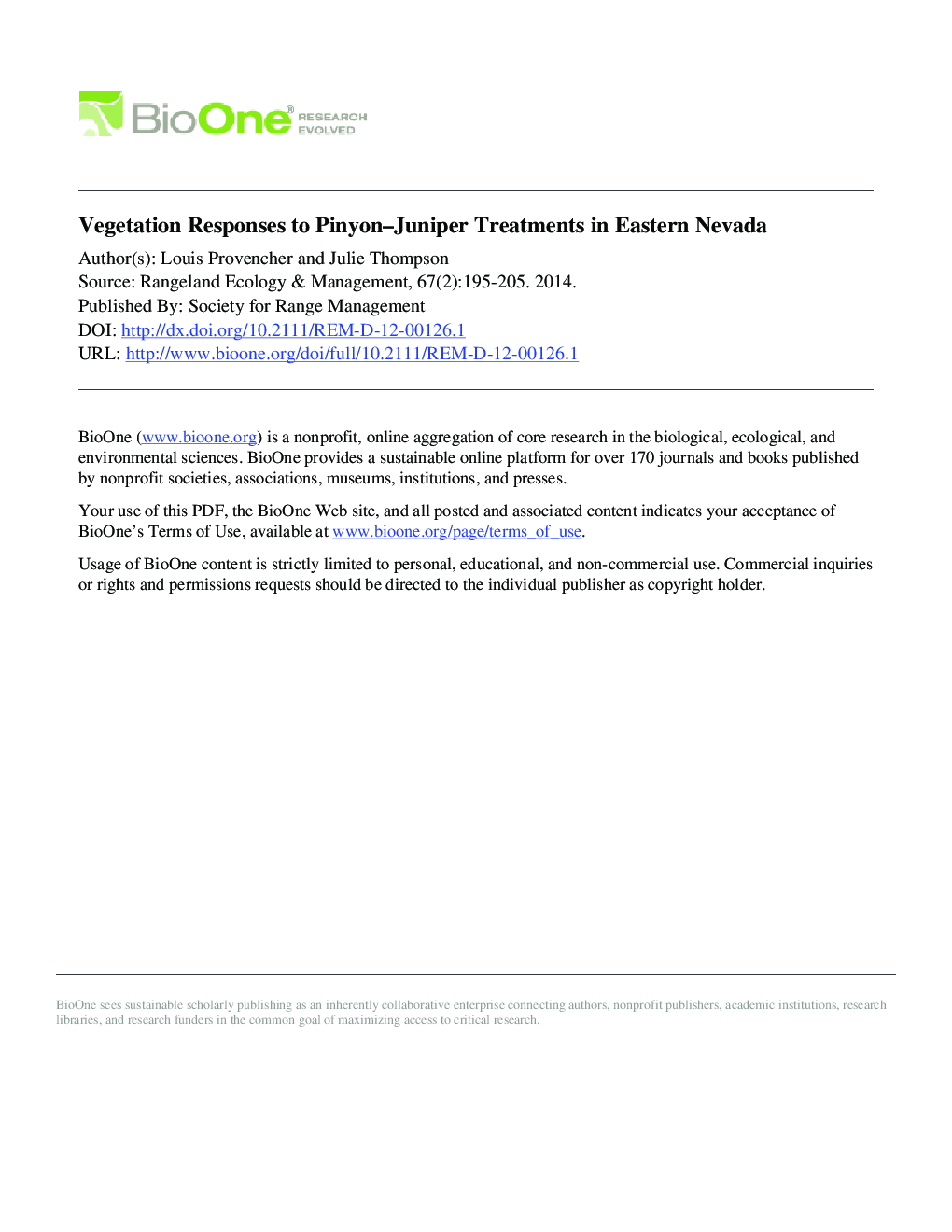| کد مقاله | کد نشریه | سال انتشار | مقاله انگلیسی | نسخه تمام متن |
|---|---|---|---|---|
| 4404491 | 1307166 | 2014 | 12 صفحه PDF | دانلود رایگان |
عنوان انگلیسی مقاله ISI
Vegetation Responses to Pinyon-Juniper Treatments in Eastern Nevada
ترجمه فارسی عنوان
پاسخ گیاه به درمانهای پینیون-کاج فرنگی در شرق نوادا
دانلود مقاله + سفارش ترجمه
دانلود مقاله ISI انگلیسی
رایگان برای ایرانیان
کلمات کلیدی
سیگاری سیاه و سفید، زنجیر دروازه بان حوضه بزرگ اصلاح چمن چند ساله،
موضوعات مرتبط
علوم زیستی و بیوفناوری
علوم کشاورزی و بیولوژیک
علوم کشاورزی و بیولوژیک (عمومی)
چکیده انگلیسی
Comparisons of tree-removal treatments to reduce the cover of single-leaf pinyon (Pinus monophylla Torr. and Frém.) and Utah juniper (Juniperus osteosperma [Torr.] Little), and subsequently increase native herbaceous cover in black sagebrush (Artemisia nova A. Nelson), are needed to identify most cost-effective methods. Two adjacent vegetation management experiments were initiated in 2006 and monitored until 2010 in eastern Nevada to compare the costs and efficacy of various tree reduction methods. One Department of Energy (DOE) experiment compared a control to five treatments: bulldozing imitating chaining ($205â·âha-1), lop-pile-burn ($2â309â·âha-1), lop-and-scatter ($1â297â·âha-1), feller-buncher and chipper ($4â940â·âha-1), and mastication ($1â136â·âha-1), whereas a second Bureau of Land Management (BLM) experiment compared one-way chaining ($205â·âha-1) to a control treatment. Chaining and bulldozing resulted in the least reduction of tree cover among the treatments. In the DOE experiment, forb cover only decreased in the mastication treatment. Litter increased in all methods. Slash cover was lowest in the control and lop-pile-burn treatments, intermediate in the feller-buncher and mastication treatments, and highest in the bulldozing and lop-and-scatter treatments. By 2010, forb cover and the combined cover of dead shrubs and trees were increased and decreased, respectively, by chaining in the BLM experiment. Nonnative annual grass and biotic crust were absent or uncommon before and after treatment implementation. In both experiments, tree removal resulted in a nonsignificant increase in perennial grass cover even 4 yr post-treatment. An ecological return-on-investment (EROI) metric was developed to compare perennial grass cover and tree cover per unit area cost of each active treatment. By 2010, chaining or bulldozing, followed by mastication, showed the highest EROI for improving perennial grass and decreasing tree cover. Mastication is recommended for restoration of smaller tree-encroached areas, whereas land managers should reconsider smooth chaining, despite its negative perceptions, for rapid and cost-efficient restoration of large landscapes obligates.
ناشر
Database: Elsevier - ScienceDirect (ساینس دایرکت)
Journal: Rangeland Ecology & Management - Volume 67, Issue 2, March 2014, Pages 195-205
Journal: Rangeland Ecology & Management - Volume 67, Issue 2, March 2014, Pages 195-205
نویسندگان
Louis Provencher, Julie Thompson,
